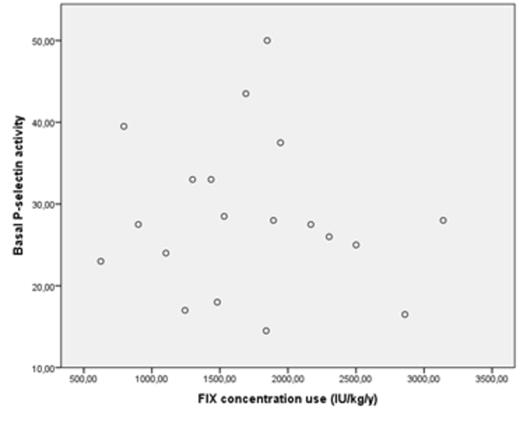Abstract
Introduction
In hemophilia, unravelling the mechanisms behind interindividual variability in phenotype remains a big challenge.
Objectives
To study platelet activation and platelet responsiveness in relation to hemostatic phenotypes in hemophilia B by 1) comparing hemophilia B patients to healthy controls and 2) relating these to the clinical phenotype of the individual patients with severe hemophilia B.
Methods
Platelet reactivity was determined in whole blood measuring expression of P-selectin and binding of fibrinogen with FACS analysis after stimulating or inhibiting platelets with concentration series of several (ant-)agonists, including adenosine diphosphate (ADP), convulxin (CVX) and thrombin receptor associated protein (TRAP)and iloprost. Concentration of soluble platelet activation markers (soluble P-selectin, β-Thromboglobulin and RANTES) were measured in platelet poor plasma by ELISA.
Markers of platelet activation and responsiveness were compared between healthy controls (n=12), patients with mild/moderate (n=12) or severe hemophilia B (n=19).
In severe hemophilia patients, annual FIX consumption/kg was calculated over the last 6 years. Data were analysed with linear regression using SPSS 20.
Results
Levels of basal platelet activation (both P-selectin and fibrinogen) were equal between controls, mild/moderate and severe hemophilia B (Figure 1). For basal P-selectin expression, the mean area under the curves for were 28.5 (95% CI 23.3-33.6), 33.0(95% CI 24.4-41.6) and 28.4(95% CI 23.9-32.9) respectively (p=0.4). After stimulation with ADP, CVX and TRAP (with and without iloprost), platelet responsiveness was similar in all groups.
There was no relation between annual FIX consumption and any marker of platelet activity. For basal P-selectin expression, the beta coefficient was -0.212 (p=0.38)(Figure 2).
Conclusion
In hemophilia B, platelet activity and responsiveness was similar to healthy controls. In severe hemophilia patients, there was no relation between FIX consumption and platelet activity.
Basal P-selectin activity between healthy controls and hemophilia patients
Basal P-selectin activity according to FIX consumption in severe hemophilia B
Schutgens:Pfizer: Research Funding.
Author notes
Asterisk with author names denotes non-ASH members.



This feature is available to Subscribers Only
Sign In or Create an Account Close Modal